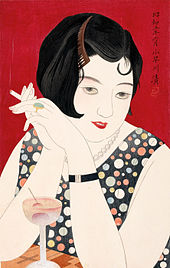|
Modern girl
Modern girls (モダンガール, modan gāru) (also shortened to moga) were Japanese women who followed Westernized fashions and lifestyles in the period after World War I. Moga were Japan's equivalent of America's flappers, Germany's neue Frauen, France's garçonnes, or China's modeng xiaojie (摩登小姐).[1] By viewing moga through a Japanese versus Western lens, the nationalist press could use the modern girl archetype to blame such failings as frivolity, sexual promiscuity, and selfishness on foreign influence.[2] The period was characterized by the emergence of working class young women with access to money and consumer goods. Using aristocratic culture as their standard of Japaneseness, the critics of the modern girl condemned her working class traits as "unnatural" for Japanese. Modern girls were depicted as living in the cities, being financially and emotionally independent, choosing their own suitors, and apathetic towards politics.[3] The woman's magazine was a novelty at this time, and the modern girl was the model consumer, someone more often found in advertisements for cosmetics and fashion than in real life. The all-female Takarazuka Revue, established in 1914,[4] and the novel Naomi (1924) are outstanding examples of modern girl culture. Origins and etymology Jun'ichirō Tanizaki's 1924 novel Naomi is credited as creating the term "modern girl". The novel was such a hit that it caused considerable outrage among elders in Japan. However, younger women embraced the story and celebrated the values displayed by several of the main characters. The character became a feature of many silent films produced in Japan at the time by directors like Yasujirō Ozu. Actresses such as Tatsuta Shizue became known for their depiction of modern girls in contrast to the more traditional values depicted by other characters in films.[5] The modern girl archetype was further bolstered by magazines such as The Housewife's Friend (主婦の友, Shufu no tomo), founded in 1917, and Woman (女性, Josei), founded in 1922; both magazines ran articles, fashion tips, and advice on the modern girl lifestyle,[6] with Josei described as "the bible of the modern girl."[7] BehaviorThe values of modern girls emphasised complete financial and emotional independence.[8] Modern girls would work service industry-style jobs and live on their own, not dependent on their family. They smoked, watched movies, and hung out at the cafes; they were sexually liberated, choosing their own suitors. Many of them participated in casual sex.[6] In a 1928 short story by Kataoka Teppei, a young typist dates three "modern boys" at the same time.[9] She is described as decadent, hedonistic, and superficial.[9] However, the ideals of modern girls were not considered to be politically-driven, nor did young women adopt modern girl values and behaviours as a direct form of protest. Instead, modern girls sought change via themselves,[clarification needed] with consumerism the first and foremost consideration and driving factor. Modern girls constantly shopped at the new department stores and listened to jazz records. Appearance A modern girl's appearance was completely Western. Modern girls wore pumps and short dresses, discarding the kimono and traditional hairstyles for Western-style "garçonne" looks; similar to flappers, the bob cut was immensely popular among modern girls, who also openly wore lipstick. Much of their dress and appearance resembled Western film stars such as Olive Thomas, Clara Bow, and Mary Pickford.[6] Pickford is used as a symbol of modernism in Naomi. End of eraThe modern girl was a symbol of Westernization, and a symbol of extravagance and self-centred choices. However, following military coups in the mid- to late 1930s, extreme Japanese nationalism, the Great Depression and the Second Sino-Japanese War, the popularity of Western fashion, ideals and entertainment declined sharply. The decline of the modern girl, previously driven by the use of disposable income on consumerism and shopping, was only exacerbated further by the severe rationing of World War II. Following World War II, the developments of post-war Japan prompted a return to the 19th century ideal of "good wife, wise mother". See also
References
Further reading
External linksWikimedia Commons has media related to Moga. |
||||||||
